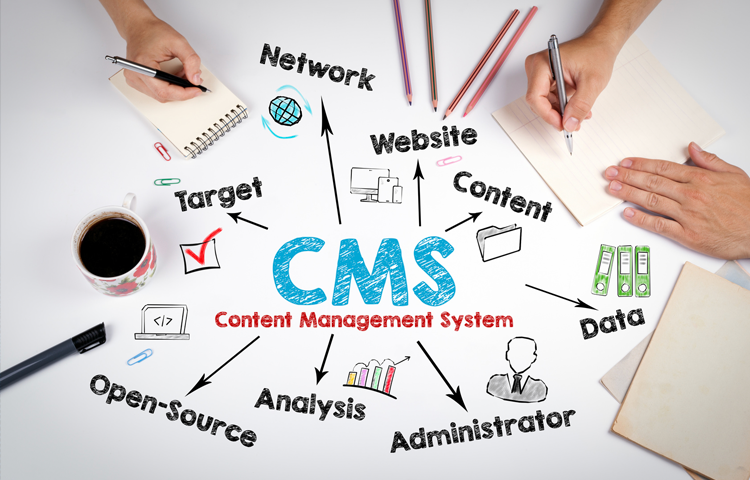

Whether you’ve got a large company with dozens or hundreds of employees, or a smaller business that employs only a few other people, a content management system (CMS) makes life easier, more organized, and manageable.
To better understand how a CMS really can increase your company’s profitability, it makes sense to understand what it is and how it works. At its most basic element, a CMS facilitates people’s ability to more efficiently manage content. Some companies use internal, proprietary CMS while others opt for licensed, internet-based software to operate websites. The software enables the creation, editing, and publishing of a wide range of content that includes text, images, videos, and forms on websites.
PHP, Perl, and Python are the languages typically used to program CMS, which are hosted locally, on company servers, or online. Generally, these systems support the very widespread MySQL database system.
Although each particular system has its own “flavor,” they share more similarities than differences. Users can define, edit, and arrange individual content modules like texts and images, for example, using HTML or WYSIWYG editors (what you see is what you get). These editors make website design very easy.
Among some of today’s more popular CMS are the following:
WordPress (Open Source, uses PHP, MySQL)
This very cost-effective CMS is fairly easy to use, so you’ll also save money on upkeep and maintenance if you or an employee is capable of updating your site’s content. It’s easily accessible and updatable—all you need is internet access anywhere, anytime. The CMS is SEO-friendly, and when you use WordPress to build a website, you’ve got instant availability to simple, constant codes that facilitates Google indexing. You can also customize each page to focus SEO campaigns on high-converting pages, for example, to rank higher in search engines.
WordPress offers syndication, which is a highly efficient method of earning inbound links to your site. New content—like blog posts—can go automatically to an RSS feed. That option makes it easier for other people to syndicate the content you generate across directories and other websites. The CMS also includes responsive web technology, which means your site’s pages adapt to fit whatever devices on which they’re viewed.
If you choose to add plugins, WordPress makes it easy. Not sure of a new feature? The site has a healthy community of users happy to share experiences and advice. And since the system operates on a universal, open source platform, it’s easy to transition its maintenance from one person (or firm) to another.
Joomla (Open Source, uses PHP, MySQL)
This CMS is also a community-driven project and is the second-largest global open source CMS. It’s used by eBay and IKEA, Harvard, and the UN Regional Information Center for Western Europe. It’s easier to use because it requires minimal expertise in coding and programming. The graphical user interface allows people to easily change colors, layouts, fonts, and features with no coding needed. On the other hand, if you do want to add a customized tweak, you can use the built-in override system to modify the system’s templates.
This CMS works well for simple and high-performing sites and looks less like a blogging platform. Since it’s a “light” PHP framework, web developers can write web and command line applications using PHP. It allows users to create multiuser and interactive websites like online storefronts, social networking sites, and e-commerce sites. WordPress still dominates with the number of plugins and themes it offers, but Joomla has nearly 8,000 of its own plugins, templates, components, library, language, modules, and packages.
Joomla’s built-in SEO tools come ready to use immediately and include keyword planning and monitoring, metadata creation and modification, sitemap generations, menu creation, robot exclusions, and support for SEO-friendly URLs. Some of the optional extensions also provide URL redirection functions, link management, native analytics, and browser standardizations.
A potential drawback to this CMS is its user interface’s degree of complexity, which is higher than WordPress’s. There’s a bit of a learning curve and it’s not as intuitive; however, many companies that use it feel it’s worth the time to learn it.
Drupal (Open Source, uses PHP, MySQL/MariaDB/PostgreSQL/SQLite/Oracle, MSSQL)
Drupal is the third-most popular global CMS because it’s reliable and stable. Its flexibility makes it a popular option for a wide variety of websites including community portal sites, intranet/corporate sites, blogs/art/portfolio/music/multimedia sites, e-commerce, resource directories, and social networking.
It includes a good degree of functionality that include polls management, a graphics modification tool, user management, and advanced menu management. Site admins can create new user accounts easily, divide users into groups, give assignments, and establish permission rights.
It’s a very scalable CMS which allows easy integration of the modules with its core. It includes over 29,000 modules and over 1,000 themed templates. The system’s structure enables users to categorize content through URL addresses, paths, and customized lists, which makes it easy to manage, search, and even reuse content. It offers a very large selection of customizable attributes in features, operation, layout, and design.
Facebook, Twitter, and Google analytics provide an extensive API support system, and it’s also SEO-friendly, like the other two major CMS.
Also like Joomla, this CMS is mobile ready and doesn’t require special programming to adjust the website view based on the device on which users view the site. It does, however, require more advanced knowledge to install and modify, and if you’ve got a very large website, the script generates a large server load which slows it down more than WordPress.
A CMS helps users to manage sites—a real benefit for sites that see a high volume of content. Users don’t need to be crackerjack programmers, either. There’s no need to access a website’s code; instead, the CMS include tools that are fairly intuitive to use. WordPress is, by all accounts, the easiest to learn whereas Drupal does require at least some basic coding/programming knowledge.
The three largest CMS also have a robust online community forum from which to seek advice and additional components to customize the system to an individual business’s specific needs.
If you agree with the following questions, chances are, your company would benefit from using a CMS-based website:


Need help navigating your AI journey?
Download our eBook for insights and tips to ease your way into adopting AI for your business – the smart and practical way!
Need help navigating your AI journey?
Download our eBook for insights and tips to ease your way into adopting AI for your business – the smart and practical way!